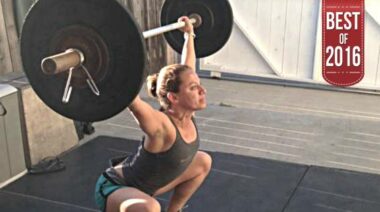If you have ever thought about adding bands to your weight training but weren’t sure where to start, a recent study in the Journal of Strength and Conditioning Research might give you some ideas.
The idea of adding resistance via elastic tubing (or sometimes chains) is two-fold. First, it helps to reduce momentum. Often when you’re lifting, the maximum force applied will be somewhere in the first half of the lift, and the weight will then coast along as you finish your rep. Second, using bands creates a condition in which the load increases as the lift progresses. Not only does this emphasize underused musculature, but it also requires a greater acceleration component. Learning to accelerate through a lift (often called compensatory acceleration) teaches you to overcome sticking points when the lift gets heavy, because you’ve developed the technique to continue exerting force throughout the lift.
In the Journal study, the researchers studied competitive female Olympic weightlifters to determine the effectiveness of bands. They used a clean pull as the exercise of choice. It’s not the lift you might traditionally see people using bands on, but it is something the participants were familiar with. Also, the second pull of a full clean is the part that requires the most power to execute.
In the test, the participants lifted in three different conditions:
- The bar was loaded with ninety percent of one-rep max for the clean pull.
- The bar was loaded with the same ninety percent, plus an elastic band rated to max out at ten percent of the bar weight.
- The bar weight again loaded with ninety percent of one-rep max, and the band rated at twenty percent of the bar weight.
In each of these conditions, power, velocity, and force were all measured to see which was the best. You might expect that because the loads were higher with the bands on, the weight would automatically require more power and force to overcome. You would be partially correct. There was an increase in power, velocity, and force by adding the bands over the empty bar.
However that’s not the whole story. Peak force was roughly the same between the two different strengths of bands, but power and velocity were significantly higher with the ten-percent band. So although adding weight with a band seems to be a good idea, there is a point of diminishing returns.
I think the study should have made use of bars loaded with weights that corresponded to the band weights as well. But at least we know that out of the three conditions present in this study, the ten-percent band improved both speed and power.
References:
1. Kampanart Paditsaeree, et. al., “Comparison Between The Effects of Combining Elastic and Free-Weight Resistance and Free-Weight Resistance on Force and Power Production,” Journal of Strength and Conditioning Research, DOI: 10.1519/JSC.0000000000000459
Photo courtesy of Becca Borawski Jenkins/Pulse Beat Fit.






